Agile software development adopts an incremental approach to building software, and agile testing methodology follows suit by incrementally testing features as they are developed. Despite agile’s widespread adoption—reportedly used by 71% of companies globally—many organizations, especially those in regulated industries needing formal documentation and traceability, still rely on waterfall or hybrid development models. Meanwhile, some teams are currently transitioning to agile methodologies.
No matter where your organization stands in the agile journey, this article aims to provide a comprehensive understanding of agile testing fundamentals, from definition, advantages, and life cycle, to effective strategy.
Without further ado, let’s dive right into it!
What is Agile Testing?
Agile testing is a form of software testing that follows agile software development principles. It emphasizes continuous testing throughout the software’s development life cycle (SDLC). Essentially, whenever there is an update to the software code, the agile testing team promptly verifies its functionality to ensure ongoing quality assurance.
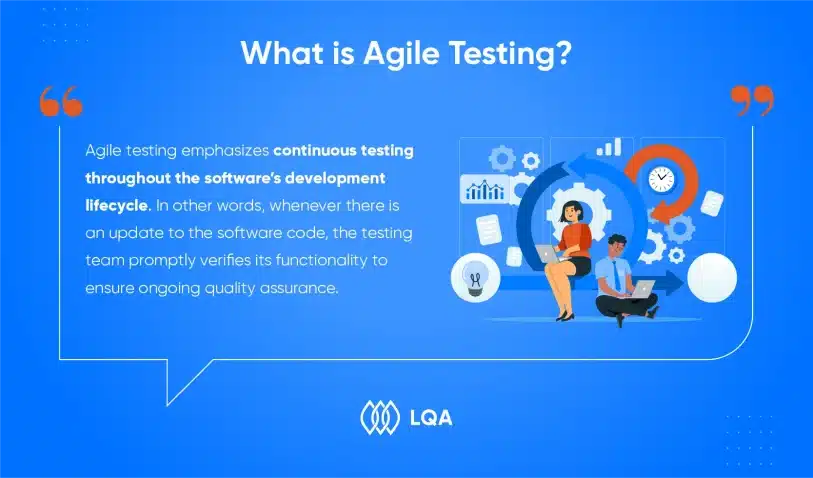
What is Agile Testing
In traditional development, testing occurred separately after the coding phase.
In agile, however, testing is an ongoing process, positioning testers between product owners and developers. This arrangement creates a continuous feedback loop, aiding developers in refining their code.
Two key components of agile software testing are continuous integration and continuous delivery.
Continuous integration involves developers integrating their code changes into a shared repository multiple times a day. Meanwhile, continuous delivery ensures that any change passing all tests is automatically deployed to production.
The primary motivation for adopting agile methodology in software testing is its cost and time efficiency. By relying on regular feedback from end users, agile testing addresses a common issue where software teams might misinterpret features and develop solutions that do not meet user requirements. This approach ensures that the final product closely aligns with user needs and expectations.
Agile Testing Life Cycle
The testing life cycle in agile operates in sync with the overall agile software development life cycle, focusing on continuous testing, collaboration, and enhancement.
Essentially, it comprises 5 key phases, with objectives outlined below:
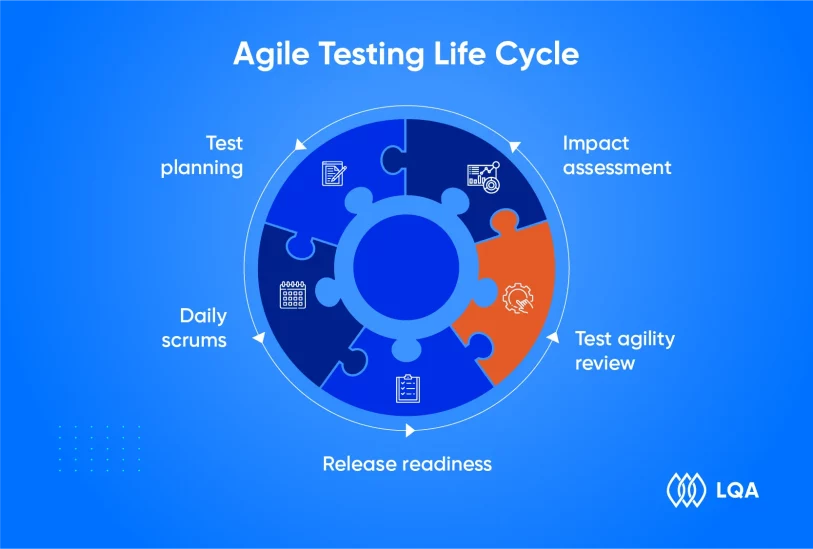
Agile Testing Life Cycle
Test planning
- Initial preparation: At the outset of a project is agile test planning, with testers working closely with product owners, developers, and stakeholders to fully grasp project requirements and user stories.
- User story analysis: Testers examine user stories to define acceptance criteria and establish test scenarios, ensuring alignment with anticipated user behavior and business goals.
- Test strategy: Based on the analysis, testers devise a comprehensive test strategy that specifies test types (unit, integration, acceptance, etc.,), tools, and methodologies to be employed.
- Test estimation: For effective test planning, it’s necessary for your team to estimate testing efforts and resources required to successfully implement each sprint of the strategy.
Check out How to create a test plan: Components, steps and template for further details.
Daily scrums (stand-ups)
- Collaborative planning: Daily scrum meetings, also known as stand-ups, facilitate synchronized efforts between development and testing teams, enabling them to review progress and plan tasks collaboratively.
- Difficulty identification: Testers use stand-ups to raise testing obstacles, such as resource limitations and technical issues, that may impact sprint goals.
- Adaptation: Stand-ups provide an opportunity to adapt testing strategies based on changes in user stories or project priorities decided in the sprint planning meeting.
Release readiness
- Incremental testing: Agile encourages frequent releases of the product’s potentially shippable increments. Release readiness testing ensures each increment meets stringent quality standards and is deployment-ready.
- Regression testing: Prior to release, regression testing in agile is conducted to validate that new features and modifications do not adversely impact existing functionalities.
- User acceptance testing (UAT): Stakeholders engage in UAT to verify software compliance with business requirements and user expectations before final deployment.
Test agility review
- Continuous evaluation: This refers to regular review sessions throughout the agile testing life cycle to assess the agility of testing processes and their adaptability to evolving requirements.
- Quality assessment: Test agility reviews help gauge the effectiveness of test cases in identifying defects early in the development phase.
Learn more: Guide to 5 test case design techniques with examples
- Feedback incorporation: Stakeholder, customer, and team feedback is all integrated to refine testing approaches, aiming to enhance overall quality assurance practices.
Impact assessment
- Change management: Change management in agile involves frequent adaptations to requirements, scope, or priorities. The impact assessment examines how these changes impact existing test cases, scripts, and overall testing efforts.
- Risk analysis: Testers examine possible risks associated with changes to effectively prioritize testing tasks and minimize risks.
- Communication: Impact assessment necessitates clear communication among development, testing, and business teams to ensure everyone comprehends the implications of changes on project timelines and quality goals.
4 Essential Components of an Agile Testing Strategy
In traditional testing, the process heavily relies on comprehensive documentation.
However, the testing process in agile prioritizes software delivery over extensive documentation, allowing testers to adapt quickly to changing requirements.
Therefore, instead of detailing every activity, teams should develop a test strategy that outlines the overall approach, guidelines, and objectives.
While there is no one-size-fits-all formula due to varying team backgrounds and resources, here are 4 key elements that should be included in an agile testing strategy.
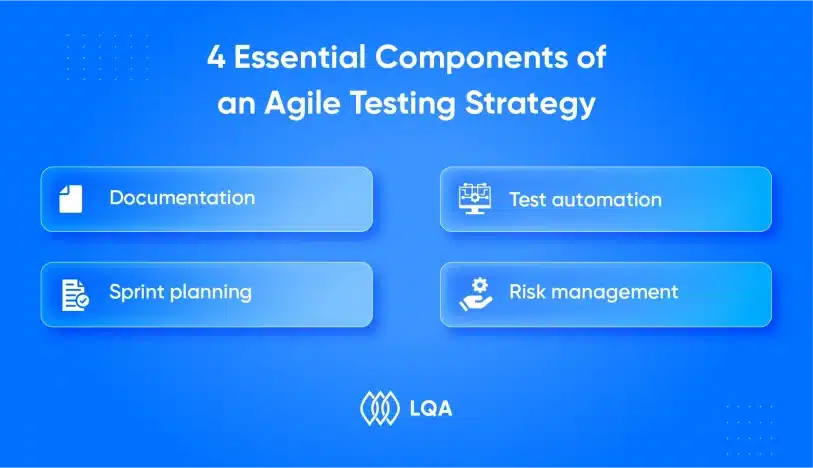
Essential Components of an Agile Testing Strategy
Documentation
The first and foremost element of an agile testing strategy is documentation.
The key task here is finding the right balance—providing enough detail to serve its purpose without overloading or missing important information.
Since testing in agile is iterative, quality assurance (QA) teams must create and update a test plan for each new feature and sprint.
Generally, the aim of this plan is to minimize unnecessary information while capturing essential details needed by stakeholders and testers to effectively execute the plan.
A one-page agile test plan template typically includes the following sections:
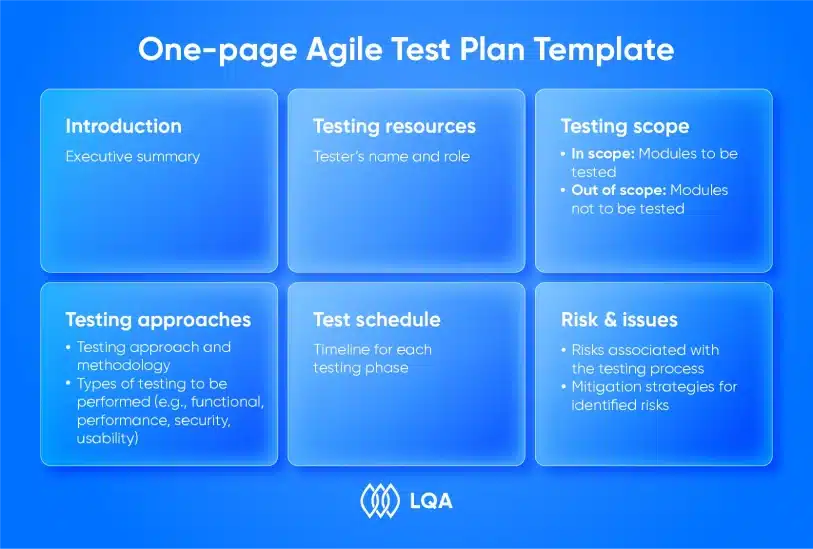
One-page agile test plan template
Sprint planning
In agile testing, it’s crucial for a team to plan their work within time-boxed sprints.
Timeboxing helps define the maximum duration allocated for each sprint, creating a structured framework for iterative development.
Within Scrum – a common agile framework, a sprint typically lasts for one month or less, during which the team aims to achieve predefined sprint goals.
This time-bound approach sets a rhythm for consistent progress and adaptability, fostering a collaborative and responsive environment that aligns with agile principles.
Apart from sprint duration, during sprint planning, a few key things should be factored in:
- Test objectives based on user stories
- Test scope and timeline
- Test types, techniques, data, and environments
Test automation
Test automation is integral to agile testing as it enables teams to quickly keep pace with the rapid development cycles of agile methodology.
But, one important question arises: which tests should be automated first?
Below is a list of questions to help you prioritize better:
- Will the test be repeated?
- Is it a high-priority test or feature?
- Does the test need to run with multiple datasets or paths?
- Is it a regression or smoke test?
- Can it be automated with the existing tech stack?
- Is the area being tested prone to change?
- Can the tests be executed in parallel or only sequentially?
- How expensive or complicated is the required test architecture?
Deciding when to automate tests during sprints is another crucial question to ask. Basically, there are two main approaches:
- Concurrent execution: Automating tests alongside feature development ensures immediate availability of tests, facilitating early bug detection and prompt feedback.
- Alternating efforts: Automating tests in subsequent sprints following feature development allows developers to focus on new features without interruption but may delay the availability of agile automated testing.
The choice between these approaches should depend on your team dynamics, project timelines, feature complexity, team skill sets, and project requirements. In fact, agile teams may opt for one approach only or a hybrid based on project context and specific needs.
Dig deeper into automation testing:
- Top 8 benefits of test automation
- A comparison between manual testing and automation testing
- How to choose the right test automation framework?
- 10 leading automation testing companies worldwide
Risk management
Conducting thorough risk analysis before executing tests boosts the efficiency of agile testing, making sure that resources are allocated effectively and potential pitfalls are mitigated beforehand.
Essentially, tests with higher risk implications require greater attention, time, and effort from your QA team. Moreover, specific tests crucial to certain features must be prioritized during sprint planning.
Agile Testing Quadrants Explained
The agile testing quadrant, developed by Brian Marick, is a framework that divides the agile testing methodology into four fundamental quadrants.
By categorizing tests into easily understood dimensions, the agile testing quadrant enables effective collaboration and clarity in the testing process, facilitating swift and high-quality product delivery.
At its heart, the framework categorizes tests along two dimensions:
- Tests that support programming or the team vs. tests that critique the product
- Tests that are technology-facing vs. tests that are business-facing
But first, here’s a quick explanation of these terms:
- Tests that support the team: These tests help the team build and modify the application confidently.
- Tests that critique the product: These tests identify shortcomings in the product or feature.
- Tests that are technology-facing: These are written from a developer’s perspective, using technical terms.
- Tests that are business-facing: These are written from a business perspective, using business terminology.
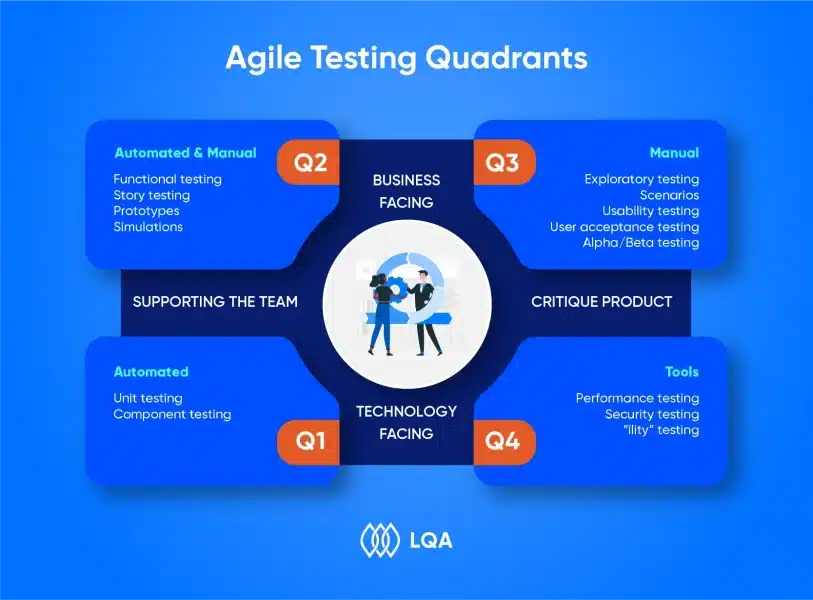
Agile Testing Quadrants Explained
Quadrant 1: Technology-facing tests that support the team
Quadrant 1 includes technology-driven tests performed to support the development team. These tests, primarily automated, focus on internal code quality and provide developers with rapid feedback.
Common tests in this quadrant are:
- Unit tests
- Integration/API tests
- Component tests
These tests are quick to execute, easy to maintain, and essential for Continuous Integration and Continuous Deployment (CI/CD) environments.
Some example frameworks and agile testing tools used in this quadrant are Junit, Nunit, Xunit, RestSharp, RestAssured, Jenkins, Visual Studio, Eclipse, etc.
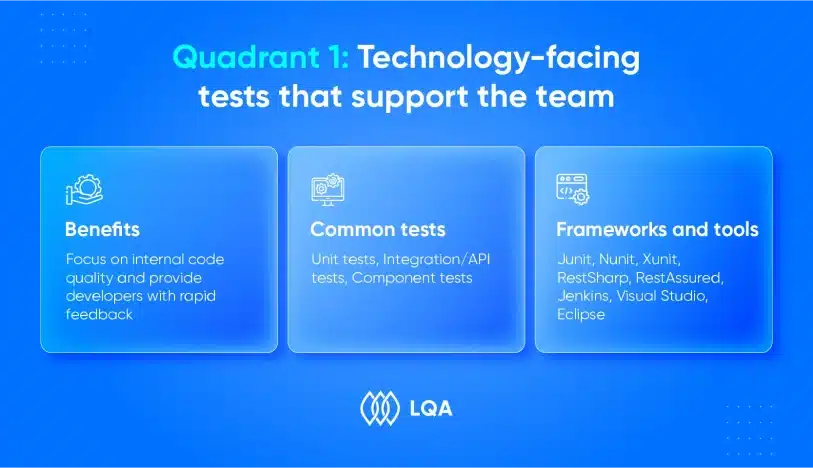
Quadrant 1: Technology-facing tests that support the team
Quadrant 2: Business-facing tests that support the team
Quadrant 2 involves business-facing tests aimed at supporting the development team. It blends both automated and manual testing approaches, seeking to validate functionalities against specified business requirements.
Tests in Q2 include:
- Functional tests
- Examples
- Story tests
- Prototypes
- Simulations
Here, skilled testers collaborate closely with stakeholders and clients to ensure alignment with business goals.
Tools like BDD Cucumber, Specflow, Selenium, and Protractor can help facilitate the efficient execution of tests in this quadrant.
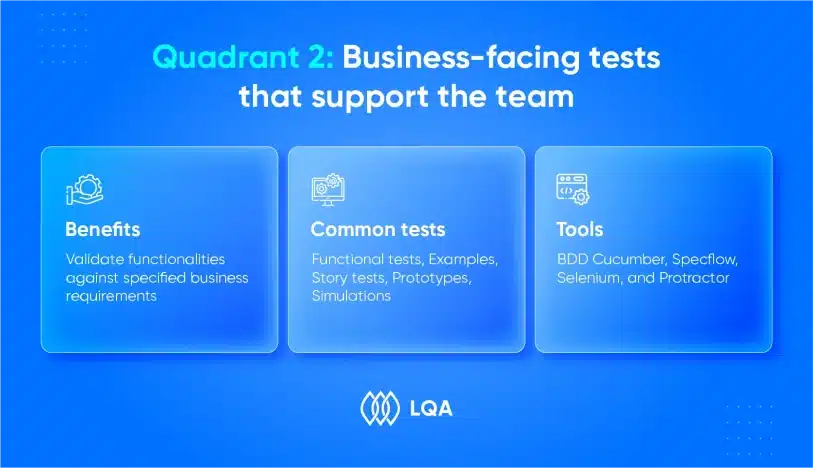
Quadrant 2: Business-facing tests that support the team
Quadrant 3: Business-facing tests that critique the product
Quadrant 3 comprises tests that assess the product from both a business and user acceptance perspective. These tests are crucial for verifying the application against user requirements and expectations.
Manual agile testing methods are predominantly used in this quadrant to conduct:
- Exploratory testing
- Scenario-based testing
- Usability testing
- User acceptance testing
- Demos and alpha/beta testing
Interestingly, during UAT, testers often collaborate directly with customers to guarantee the product meets user needs effectively.
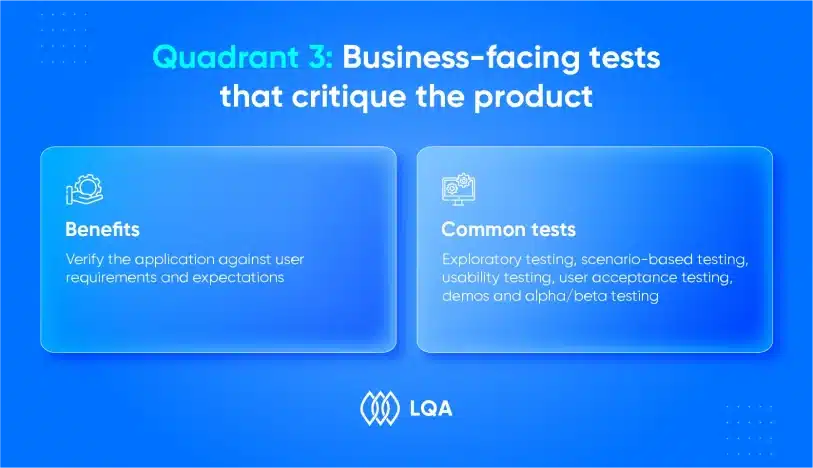
Quadrant 3: Business-facing tests that critique the product
Quadrant 4: Technology-facing tests that critique the product
Quadrant 4 focuses on technology-driven tests that critique the product’s non-functional aspects, covering from performance, load, stress, scalability, and reliability to compatibility and security testing.
Automation tools to run such non-functional tests include Jmeter, Taurus, Blazemeter, BrowserStack, and OWASP ZAP.
All in all, these four quadrants serve as a flexible framework for your team to efficiently plan testing activities. However, it’s worth noting that there are no strict rules dictating the order in which quadrants should be applied and teams should feel free to adjust based on project requirements, priorities, and risks.
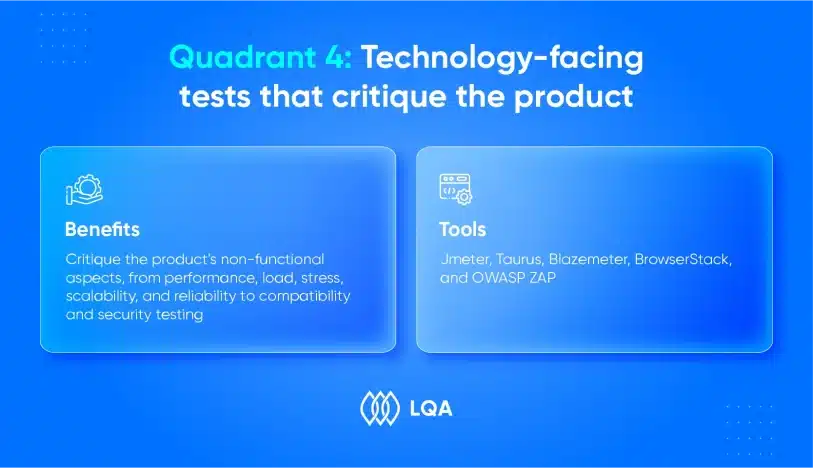
Quadrant 4: Technology-facing tests that critique the product
Advantages of Agile Testing
Agile testing offers a host of benefits that seamlessly integrate with the agile development methodology.
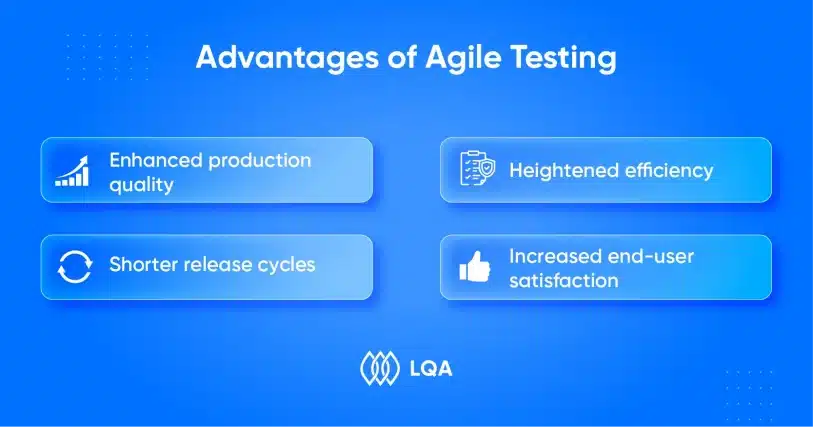
Advantages of Agile Testing
- Shorter release cycles
Unlike traditional development cycles, where products are released only after all phases are complete, agile testing integrates development and testing continuously. This approach ensures that products move swiftly from development to deployment, staying relevant in a rapidly evolving market.
- Higher quality end product
Agile testing enables teams to identify and fix defects early in the development process, reducing the likelihood of bugs making it to the final release.
- Improved operational efficiency
Agile testing eliminates idle time experienced in linear development models, where testers often wait for projects to reach the testing phase. By parallelizing testing with development, agile maximizes productivity, enabling more tasks to be accomplished in less time.
- Enhanced end-user satisfaction
Agile testing prioritizes rapid delivery of solutions, meeting customer demands for timely releases. Continuous improvement cycles also ensure that applications evolve to better meet user expectations and enhance overall customer experience.
FAQs about Agile Testing
What is agile methodology in testing?
Agile testing is a form of software testing that follows agile software development principles. It emphasizes continuous testing throughout the software’s development lifecycle. Essentially, whenever there is an update to the software code, the testing team promptly verifies its functionality to ensure ongoing quality assurance.
What are primary principles of agile testing?
When implementing agile testing, teams must uphold several core principles as follows:
- Continuous feedback
- Customer satisfaction
- Open communication
- Simplicity
- Adaptability
- Collaboration
What are some common types of testing in agile?
Five of the most widely adopted agile testing methodologies in current practice are:
- Test-driven development
- Acceptance test-driven development
- Behavior-driven development
- Exploratory testing
- Session-based testing
What are key testing metrics in agile?
Agile testing metrics help gauge the quality and effectiveness of testing efforts. Here are some of the most important metrics to consider:
- Test coverage
- Defect density
- Test execution progress
- Test execution efficiency
- Cycle time
- Defect turnaround time
- Customer satisfaction
- Agile test velocity
- Escaped defects
Final Thoughts about Agile Testing
Agile testing aligns closely with agile software development principles, embracing continuous testing throughout the software lifecycle. It enhances product quality and enables shorter release cycles, fostering customer satisfaction through reliable, frequent releases.
While strategies may vary based on team backgrounds and resources, 4 essential elements that should guide agile testing strategies are documentation, sprint planning, test automation, and risk management.
Also, applying the agile testing quadrants framework can further streamline your team’s implementation.
At LTS Group, we boast a robust track record in agile testing—from mobile and web applications to embedded software and automation testing. Our expertise is validated by international certifications such as ISTQB, PMP, and ISO, underscoring our commitment to excellence in software testing.
Should you have any projects in need of agile testing services, drop LQA a line now!



